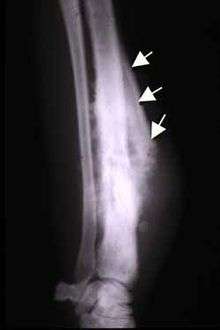Codman triangle
Codman triangle (previously referred to as Codman's triangle) is the triangular area of new subperiosteal bone that is created when a lesion, often a tumour, raises the periosteum away from the bone.[1] A Codman triangle is not actually a full triangle. Instead, it is often a pseudotriangle on radiographic findings, with ossification on the original bone and one additional side of the triangle, which forms a two sided triangle with one open side. This two sided appearance is generated due to a tumor (or growth) that is growing at a rate which is faster than the periosteum can grow or expand, so instead of dimpling, the periosteum tears away and provides ossification on the second edge of the triangle.[2] The advancing tumour displaces the perisosteum away from the bone medulla. The displaced and now lateral periosteum attempts to regenerate underlying bone. This describes a periosteal reaction.

The main causes for this sign are osteosarcoma, Ewing's sarcoma, eumycetoma, and a subperiosteal abscess.[3][4]
References
- General Practice notebook
- Periosteal Reaction
- Shapeero LG, Vanel D, Sundaram M, Ackerman LV, Wuisman P, Bauer TW, Neuenschwander S, Contesso G, Janney C, McDonald DJ (1994). "Periosteal Ewing sarcoma". Radiology. 191: 825–31. doi:10.1148/radiology.191.3.8184073. PMID 8184073.
- Imaging in Classic Osteosarcoma